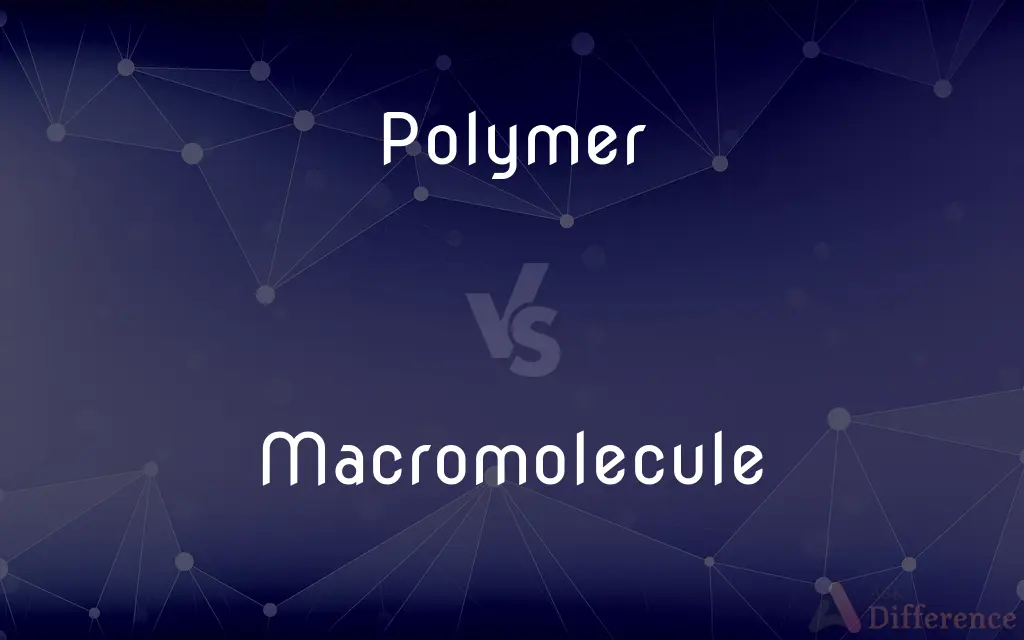Polymer vs. Macromolecule — What's the Difference?
By Urooj Arif & Fiza Rafique — Updated on March 13, 2024
Polymers are large molecules composed of repeating subunits, while macromolecules are broad class of large molecules, including polymers, crucial in biology and chemistry.

Difference Between Polymer and Macromolecule
Table of Contents
ADVERTISEMENT
Key Differences
Polymers are specific types of macromolecules characterized by their structure of repeating units, known as monomers, which are covalently bonded to form long chains. Macromolecules, on the other hand, represent a broader category of large molecules essential for life, including not only polymers but also proteins, nucleic acids, and certain complex carbohydrates.
The key distinction between polymers and macromolecules lies in the repetition of units. Polymers always consist of repeating monomeric units, which can be identical or different, giving them a wide range of properties and applications. Macromolecules may or may not have repeating units and include a diverse group of substances such as DNA, proteins, and certain polysaccharides.
In terms of synthesis, polymers can be formed through polymerization processes, which involve the chemical linking of monomers. This process can be natural, as in the synthesis of biopolymers like cellulose and proteins, or synthetic, as in the production of plastics and resins. Macromolecules can be formed through various biosynthetic pathways in living organisms or synthetic methods in the laboratory, not limited to polymerization.
Functionally, polymers play diverse roles depending on their chemical structure and the nature of their monomers. They can serve as structural materials, in energy storage, or as functional molecules in biological contexts. Macromolecules, due to their broader classification, are fundamental to biological systems, involved in virtually every process of life, from genetic information storage in nucleic acids to catalysis in proteins and energy storage in complex carbohydrates.
The distinction is also evident in their applications. Polymers, both natural and synthetic, have a wide range of uses in industries such as textiles, plastics, and biomedicine. Macromolecules, particularly those found in biological systems, are crucial for the structure and function of cells and organisms, and their study is central to biochemistry and molecular biology.
ADVERTISEMENT
Comparison Chart
Definition
Large molecules made up of repeating subunits called monomers.
A broad class of large molecules, including polymers, proteins, nucleic acids, and certain complex carbohydrates.
Repeating Units
Always consists of repeating units.
May or may not have repeating units.
Synthesis
Formed through polymerization processes.
Formed through various biosynthetic pathways or synthetic methods.
Functions
Diverse roles, including structural materials, energy storage, and functional molecules.
Fundamental to biological systems, involved in processes like genetic information storage, catalysis, and energy storage.
Applications
Wide range of industrial uses, including in textiles, plastics, and biomedicine.
Crucial for the structure and function of cells and organisms, with importance in biochemistry and molecular biology.
Compare with Definitions
Polymer
Polymers are large molecules composed of repeating monomeric units linked by covalent bonds, exhibiting a wide range of physical and chemical properties.
Polyethylene, a synthetic polymer, is widely used in packaging materials due to its durability and flexibility.
Macromolecule
Macromolecules are large molecules that are fundamental to biological structures and processes, including proteins, nucleic acids, and certain complex carbohydrates.
DNA, a macromolecule, carries the genetic blueprint of organisms, essential for inheritance and cellular function.
Polymer
Natural polymers like cellulose and proteins are essential for life, providing structural support and carrying out vital biological functions.
Cellulose, a natural polymer found in plant cell walls, is critical for plant structure and support.
Macromolecule
Proteins, as macromolecules, perform a vast array of functions, including catalysis, structural support, and transport.
Hemoglobin, a protein macromolecule, transports oxygen in the blood, crucial for cellular respiration.
Polymer
Polymers undergo various polymerization processes, including addition and condensation polymerization, to form long chains of monomers.
Nylon, created through condensation polymerization, is utilized in textiles and ropes for its durability.
Macromolecule
Macromolecules like polysaccharides serve as energy stores and structural components in living organisms.
Starch, a polysaccharide macromolecule, stores energy in plants and is a significant food source for humans.
Polymer
The properties of polymers, such as strength, elasticity, and permeability, are determined by the nature of their monomers and the structure of the polymer chain.
Silicone polymers are used in medical devices and cookware for their heat resistance and flexibility.
Macromolecule
The synthesis of macromolecules in biological systems involves complex pathways that regulate cellular function and organismal development.
The synthesis of protein macromolecules through transcription and translation is fundamental to gene expression.
Polymer
Synthetic polymers can be engineered for specific applications, leading to innovations in materials science and technology.
Kevlar, a high-strength synthetic polymer, is used in bulletproof vests and high-performance sporting equipment.
Macromolecule
The study of macromolecules is central to biochemistry and molecular biology, shedding light on the mechanisms of life at the molecular level.
The study of macromolecules like enzymes has led to advancements in biotechnology and medicine, including drug development.
Polymer
A polymer (; Greek poly-, "many" + -mer, "part") is a substance or material consisting of very large molecules, or macromolecules, composed of many repeating subunits. Due to their broad spectrum of properties, both synthetic and natural polymers play essential and ubiquitous roles in everyday life.
Macromolecule
A macromolecule is a very large molecule, such as a protein. They are composed of thousands of covalently bonded atoms.
Polymer
Any of numerous natural and synthetic compounds of usually high molecular weight consisting of up to millions of repeated linked units, each a relatively light and simple molecule.
Macromolecule
A very large molecule, such as a polymer or protein, consisting of many smaller structural units linked together. Also called supermolecule.
Polymer
(organic chemistry) A long or larger molecule consisting of a chain or network of many repeating units, formed by chemically bonding together many identical or similar small molecules called monomers. A polymer is formed by polymerization, the joining of many monomer molecules.
Macromolecule
A very large molecule, especially used in reference to large biological polymers (e.g. nucleic acids and proteins).
Polymer
A material consisting of such polymer molecules.
Macromolecule
A very large molecule, especially a polymer having from hundreds to many thousands of atoms, such as DNA, RNA, protein, polysaccharide, polyethylene, polycarbonate, etc.
Polymer
Any one of two or more substances related to each other by polymerism; specifically, a substance produced from another substance by chemical polymerization.
Macromolecule
Any very large complex molecule; found only in plants and animals
Polymer
A naturally occurring or synthetic compound consisting of large molecules made up of a linked series of repeated simple monomers
Common Curiosities
How are macromolecules synthesized in living organisms?
Macromolecules are synthesized through various biosynthetic pathways, including polymerization for polymers, transcription and translation for proteins, and replication for nucleic acids.
What defines a polymer?
A polymer is defined by its structure of long chains formed by repeating monomeric units linked by covalent bonds.
What are some common functions of polymers in biological systems?
In biological systems, polymers like DNA and proteins are involved in genetic information storage, structural support, and enzymatic functions.
How do macromolecules differ from polymers?
Macromolecules encompass a broader class of large molecules, including polymers as well as proteins, nucleic acids, and certain complex carbohydrates, not all of which have repeating units.
What is the significance of the repeating units in polymers?
The repeating units in polymers determine the physical and chemical properties of the polymer, influencing its strength, elasticity, and reactivity.
How do synthetic polymers impact the environment?
Synthetic polymers, particularly non-biodegradable plastics, can have significant environmental impacts, including pollution and harm to wildlife.
Can all polymers be considered macromolecules?
Yes, all polymers are a type of macromolecule, but not all macromolecules are polymers.
What is the importance of studying macromolecules in biochemistry?
Studying macromolecules is crucial in biochemistry to understand the molecular basis of life, including the mechanisms of diseases and the development of pharmaceuticals.
How are polymers recycled or degraded in the environment?
Polymers can be recycled through mechanical or chemical processes, but their degradation in the environment depends on their chemical structure, with some being more resistant to breakdown than others.
What role do synthetic polymers play in modern society?
Synthetic polymers play critical roles in various industries, including manufacturing, healthcare, and technology, due to their versatile properties and applications.
Are proteins considered polymers?
Yes, proteins are considered polymers because they are made up of repeating units of amino acids linked by peptide bonds.
How does the structure of macromolecules affect their function?
The structure of macromolecules, including their size, shape, and the arrangement of their constituent parts, directly influences their biological functions and interactions.
What advancements have been made in the field of macromolecular science?
Advancements in macromolecular science include the development of biodegradable polymers, nanotechnology applications, and new therapeutic drugs based on macromolecular design.
What is the role of nucleic acids among macromolecules?
Nucleic acids, such as DNA and RNA, are macromolecules that store and transmit genetic information, playing a key role in heredity and protein synthesis.
Can macromolecules be engineered for specific purposes?
Yes, macromolecules, including both natural and synthetic polymers, can be engineered for specific applications in medicine, technology, and materials science.
Share Your Discovery

Previous Comparison
Heron vs. Crane
Next Comparison
Examination vs. AssessmentAuthor Spotlight
Written by
Urooj ArifUrooj is a skilled content writer at Ask Difference, known for her exceptional ability to simplify complex topics into engaging and informative content. With a passion for research and a flair for clear, concise writing, she consistently delivers articles that resonate with our diverse audience.
Co-written by
Fiza RafiqueFiza Rafique is a skilled content writer at AskDifference.com, where she meticulously refines and enhances written pieces. Drawing from her vast editorial expertise, Fiza ensures clarity, accuracy, and precision in every article. Passionate about language, she continually seeks to elevate the quality of content for readers worldwide.
















































